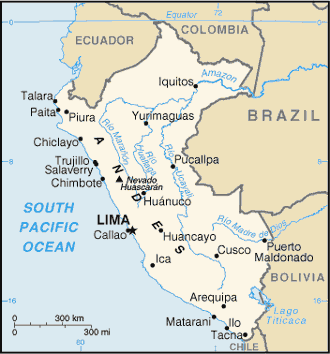Capital: Lima
Population: 27.1 million (UN, 2003)
Year of Independence: 1821, from Spain
Type of Government: Constitutional Republic
GNP: $132 billion (2001 est.)
Natural Resources: copper, silver, gold, petroleum, timber, fish, iron ore, coal, phosphate, potash, hydropower, natural gas
Date of Independence: American Popular Revolutionary Alliance (APRA) [now Peruvian Aprista Party or PAP as of April 2001]; Independent Moralizing Front (FIM); National Unity (Unidad Nacional or UN); Perú Posible (PP); Popular Action (AP); Solucion Popular; Somos Perú (SP); Union for Perú (UPP)
see map
Perú’s lush farming oases in the coastal desert have provided the country’s inhabitants with an agricultural livelihood, but its undeveloped eastern forests have led to the country’s current struggles to stop the illegal production of coca. Perú’s booming coca leaf trade has in the past few years been seriously challenged by the government’s crackdowns on drug trafficking. A majority of the population is indigenous and shares the brunt of the country’s burden of poverty — 30 percent of the country lives at this level. The wealth remains in the hands of the few elite descendants of Spanish rule despite the efforts of the current president, Alejandro Toledo Manrique, and his government-ousted authoritarian-minded predecessor, Alberto Fujimori. Active guerilla groups violently protest the ubiquitous corruption that has kept Perú’s government — and its people — from developing more completely or successfully its infrastructure and its economy.



